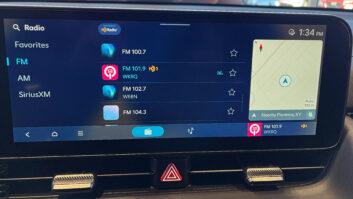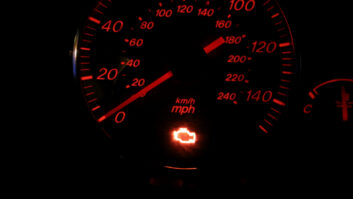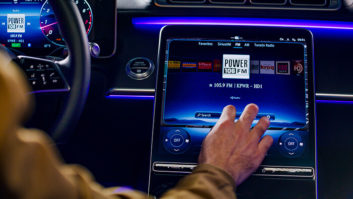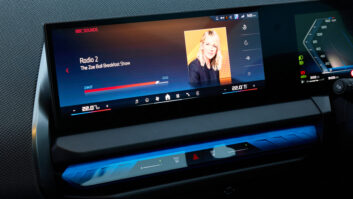“Radio can no longer be about sound coming out of a box.” So says Fred Jacobs, president of Jacobs Media, writing in the company’s latest TechSurvey. Radio World contributor Tom Vernon digs into the numbers.
— Paul McLane
As traditional radio fights its way in the home and office, the automotive environment becomes ever more important for listening.
In fact, half of all radio listening is done on the road. Nevertheless, many radio managers appear to lack understanding of this space.
That is one of the conclusions in TechSurvey10, conducted by Fred Jacobs, president of Jacobs Media. “TS10” surveyed the listening habits of 11 formats’ core audiences spanning five generations, totaling some 37,000 respondents. From Boomers to Millennials, various patterns of consumption emerged.
The automotive environment figures prominently in TS10, as the connected car movement continues to gain momentum. Nearly a fifth (19 percent) of respondents say the vehicle they use most often has a system like Audi Connect or Ford Sync. And the good news for broadcasters is that half of them do the bulk of their radio listening while on the road, and this trend is especially noticeable in younger listeners.

The bad news is that competition for the ears and attention span of drivers is only going to intensify in the coming years. Fortunately, radio has not been forgotten by younger listeners.
HIGH ON THE LIST
“When people are asked what features are most important in a car,” said Jacobs, “AM-FM radio is high on the list, the number one item in many surveys.” While the AM-FM radio isn’t going away, there is no longer a physical button to push. In its place, there are ‘soft’ buttons that users can prioritize with their choice of Bluetooth, satellite radio, MP3s, Pandora or terrestrial radio. Up to 60 percent of TS10 respondents also connect their phone through the car’s external input jack. “This number is somewhat higher for Generation Y and Z listeners,” said Jacobs.
The digital dash gives AM-FM radio parity with other media — and this might not be good if stations are not prepared. Services like Pandora automatically arrive with metadata such as album art, artist and song title. Radio has made efforts with RDS and HD Radio Artist Experience, but the level and quality of delivery remains inconsistent. “Listeners expect this data to be part of their experience,” said Jacobs. “Radio can no longer be about sound coming out of a box.”
In this new world of the connected car, the dealers take on a more important role.
“When consumers have problems with the digital dashboard, they call the dealer. This is a great opportunity for stations,” Jacobs said. By forming a relationship with dealers, the station can be programmed onto one of the soft buttons so that it is easily accessible. Dealers may also demonstrate to customers how to load broadcast stations onto soft keys.
“For broadcasters to effectively play in this space, they’ll need a comprehensive strategy in order to maintain presence in the ‘center stack,’ as well as maintaining and growing advertising revenue.”
He also noticed a rather surprising gap between average consumers and radio staff when it comes to ownership of connected cars.
“Around 19 percent of our survey respondents drive a connected car, and according to our polls of station personnel, the ownership rate is between 5 and 10 percent,” said Jacobs. The average age of a car on the road is 11 years old, and radio station staffs appear to be on the far end of that curve.
This is another area where a relationship with dealers can help because they can help to educate station staff on the ever-changing car entertainment environment.
DISAPPEARING ANTENNAE
While the high-tech changes in cars seem to be grabbing all the headlines, Jacobs notes that there are some low-tech changes that should concern broadcasters.
The humble AM-FM receiving antenna, once a chrome-plated mast riding proud on the fender, has disappeared from sight. As cars have become more aerodynamic, the antenna is now a strip of wire embedded in the windshield or in the bumper. The problem is that this type of antenna is not nearly as sensitive as those external masts that were used up to the 1990s. Recent A-B comparisons of roof-mounted external antennae and a internal antennae have demonstrated a dramatic difference in received signal strength, not only on HD Radio signals, but conventional FMs as well.
Any discussion of connected cars also raises concerns about distracted drivers. Much of the interface in many of the systems is controlled via voice commands, and there is a general goal to build a great experience that helps drivers get what they’re looking for without disrupting their focus on the road. Most developers regularly interface with government agencies, such as the National Highway Traffic Safety Administration, to help achieve this.
THIS MEANS WAR
Some of the most fascinating insights from TS10 involve the coming battle for control of the connected car.
Each automotive manufacturer has developed their own system for navigating through and controlling the connected environment — including media functions. This means, for example, getting out of a Ford vehicle, which has Sync, and climbing into a General Motors vehicle that uses MyLink or a Chrysler with uConnectcan be a confusing experience.
There are two competing forces striving to bring harmony to this chaos.
On one hand, a move is underway among car manufacturers to develop standards, so that the telematics systems in all vehicles operate in the same way.
On the other hand, Google recently announced formation of the Open Automotive Alliance, a global alliance of technology and auto industry leaders including Audi, GM, Honda, Hyundai, as well as visual computing company Nvidia. They are committed to bringing the Android platform to cars starting in 2014.
And Apple recently announced CarPlay, in which iPhone owners will be able to link their content directly into the dashboard.
“It’s really like the Wild West at this point,” said Jacobs, echoing a term that has been noted before in Radio World’s coverage of the connected car. “Who will win out is anybody’s guess.”
Jacobs Media co-sponsors a conference in Detroit to examine these issues, with participants from broadcasting, automotive (OEMs and Tier Ones), advertising agencies, car dealerships and other interested sectors. “Radio people have dealt with the auto industry for decades, but usually only when pitching business, setting up a remote, or buying a car themselves,” said Jacobs.
Tom Vernon is a longtime contributor to Radio World. Find more of his articles by searching keyword “Vernon” on radioworld.com.







